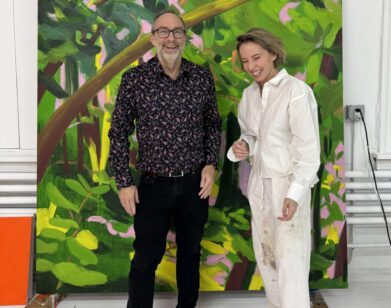Moroso: Sitting Pretty

Â
One the Friday before the International Contemporary Furniture Fair, Moroso creative director Patrizia Moroso pulls out a stack of product catalogues, retrospectives of products, and what appears to be a textbook history of her company, now past its half-decade anniversary of designing furniture. Effusive, with bobbed hair and a bright, expressive face, Patrizia is flush with pride; if it were up to her we would look at the entire trajectory of Moroso, because nothing tells the story of the brand better than historyâ??from the workshop her father opened after WWII to a high-end, haute brand in the seventies, to a courageous, art-and-architecture driven powerhouse in the eighties and nineties.
Today, Moroso is synonymous with forward-thinking design, redefining traditional concepts of the way people interact with space, instead of just making sofas. Thanks to Patrizia, the firm has earned a reputation as the go-to gauge of tomorrow’s stars. Patrizia’s support and ambition have both launched and culled from some of design’s biggest names: Patricia Uriquola, Konstantin Grcic, Toshiyuki Kita, Ron Arad and Antonio Citterio (of B&B Italia). In the face of the global financial crisis, Moroso maintains hers is a family business based on creative collaborations with architects, artists and designers. As long as creative people need to sitâ??or stand, or to have lawn furniture make magic in their gardenâ??there will be a place for Moroso.
LEILA BRILLSON: Tell me how you got involved with your parents’ company.
PATRIZIA MOROSO: At the beginning of the eighties, there was a great crisis around the world. I was a student at the time at an art school in Bologna, but the family asked me to come back and do something. We were wondering what to do now. We had no international market.
LB: And you wanted to work with you family?
PM: I was happy to do something… if I was free. Let me do something my way. My intention was to work with designers. The company, at the time, was goodâ??a good group of traditional, unchallenging sofas. But there was no design research, no specialization. With Massimo Iosa Ghini, we created the first design collection called Dinamic, and it was a huge success-for a little company from the countryside.
Â
LB: So what did you parents think about their hip young artist daughter taking over their decades-old furniture line?
PM: You know, they knew I was the crazy, art-school daughter. They suffered a bit because I was not what they imagined. But in the end, they let me make choices. My head was full of fantastic ideas about revolutionary objects. It is uncommon for the sons and daughters of the big companies from the Italian boom in the seventies to take over the business. To see me interested, even in the “crazy things,” still made them happy. I showed them that my new, experimental perspective worked, and now the company is only those “crazy things.” I respect the past. But the past is the past.
LB: What was Salone like this year, especially with the economic woes facing the industry?
PM: Milan was a fantastic year. Everyone was waiting for Milan to understand if the crisis would continue. I know that everyone, especially people coming from the US, was finally like, “Hey! A positive moment.” Maybe its time to relax, maybe we can think things are getting better.
LB: What is exciting about ICFF? Does it compare to Milan in terms of its influence?
PM: As far as design is concerned, Milan is the only fair. There are no other influential occasions for contemporary design besides Salone. But of course, New York is New York. ICFF is important because New York is important.
LB: Aside from you and [friend and Moroso-affiliate] Patricia Uriquola, there aren’t a lot of women in design. In a predominately male industry, how important is it to find women designers? Are there emerging female designers you are interested in?
PM: Lots of journalists and critics are women, but none of the producers or designers are, so in the beginning, it was very hard for me. It doesn’t make sense: it’s such a feminine, womanly thing to design. When I met Patricia, I was like, “This is the girl.” She had the passion and the energy of a great designer, but she was a woman, and we have a deep understanding. Then, some years ago, I found Nipa Doshi (of the firm Doshi Levien), and her work has a specific feminine grace. I find that a woman has a unique way of paying close attention to detail; the way we touch an object, the curves.
This year, we exhibited furniture produced by a group of Scandinavian women called Front, which took enlarged pictures of material and used them as upholstery. So you have a soft bench that looks like its wooden, or a draped sofa that was actually flat.
LB: What happens to design in a recession? Will Moroso be able to sustain itself?
PM: We are a tiny company, with a very specific audience. We aren’t doing mass production, so we don’t have those large-scale problems. Our intention is more cultural, its not about money or products but research and design. We are increasing our collaborations with artists, because of how important it is, right now, for design to expand.
For more ICFF coverage, read on.






